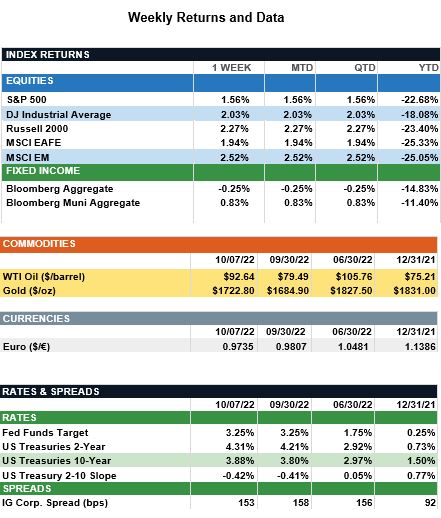Market Recap – Week Ending Oct 7
Volatility Remains Elevated, Job Report Released
Overview: Stocks were higher across the globe last week as volatility in the markets remained elevated. In the U.S., the S&P 500 index finished the week 1.6% higher, as investors hoped for a sooner-than-expected reversal in the Federal Reserve trajectory for interest rates. International stocks followed the overall positive trend for the week, with both international developed (MSCI EAFE) and emerging markets (MSCI EM) up 1.9% and 2.5%, respectively. In the energy markets, oil prices were up sharply last week as OPEC+ agreed to cut production by two million barrels per day, the largest reduction since 2020. The benchmark WTI oil price closed the week at $92.64, up over $13 per barrel for the week. In economic data, the U.S. ISM Manufacturing Index fell to 50.9, its lowest level since May 2020. This ISM Index is a leading indicator for the level of economic activity in the manufacturing sector in the U.S. and slowing manufacturing data has contributed to concerns for economic growth. Bond yields have risen recently on growth concerns, with the 2-year and 10-year Treasury yields both rising on the week to 4.31% and 3.88%, respectively. Federal Reserve officials continue to state their commitment to taming inflation while keeping an eye on data. One key indicator for the Fed is the labor market, which remains strong. In the monthly jobs report released last Friday, payrolls rose 263,000, above expectations. Meanwhile, the unemployment rate fell from 3.7% to 3.5%, partially due to a decline in labor force participation. This week, focus will be on the Thursday consumer price index (CPI) report, with headline inflation expected to fall to 8.1% for September, down from 8.3% in August.
Update on Oil Prices (from JP Morgan): OPEC+ defended its decision as necessary to protect both the oil industry and their domestic economies from rising rates and slowing growth. OPEC+ announced its plan to reduce oil output by two million barrels/day starting in November. It is worth emphasizing this is a quota cut and the actual dip in production is expected to be closer to >1M barrels/day. Nonetheless, it will aggravate the supply/demand imbalance, especially as EU and G7 sanctions are set to commence in December. OPEC+ defended its decision as necessary to protect both the oil industry and their domestic economies from rising rates and slowing growth. OPEC+ is likely fearful a possible recession in 2023 could trigger demand and price destruction. On the other hand, the decision defied the G7’s pleas for greater production in face of a snowballing European energy crisis. Thus, it could be implied this was a political dig in the ongoing energy war. OPEC+’s move will likely trigger U.S. countermeasures. It is possible the U.S. could dial back sanctions on Venezuela, allowing the nation to ramp up oil exports. Reopening Venezuela, home to 18% of the world’s oil reserves, would send a powerful signal, but would take time to impact global supply. The U.S. also could release additional supply from its Strategic Petroleum Reserve (SPR). At the time of writing, President Biden called for the release of an additional 10 million barrels from the SPR next month, but more could come. The decision also could bring the No Oil Producing and Exporting Cartels Act (NOPEC) back on the table. As of late, we have seen oil prices fall from a summer high of $122 on June 8 to $76 on Sept. 26. This was a relief for Americans who faced a national average of $5.47/gallon in June down to $4.29 in September. Unfortunately, the upside risk to oil hitting above $100 again is elevated, given OPEC+’s decision and the looming winter weather. Looking ahead, oil may not be the near-term disinflationary force we once thought and is likely to encourage continued Fed hawkishness.

Sources: JP Morgan Asset Management, Goldman Sachs Asset Management, Barron’s, Bloomberg
This communication is for informational purposes only. It is not intended as investment advice or an offer or solicitation for the purchase or sale of any financial instrument.
Indices are unmanaged, represent past performance, do not incur fees or expenses, and cannot be invested into directly. Past performance is no guarantee of future results.